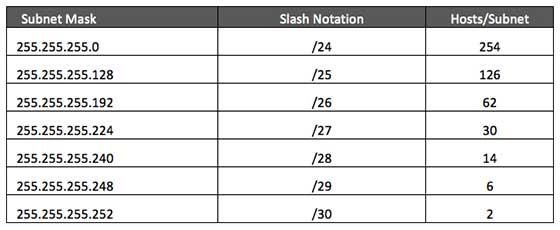In This Section we have Describe that how to subnet a Network Address.
Internet Service Providers may face a situation where they need to allocate IP subnets of different sizes as per the requirement of customer. One customer may ask Class C subnet of 3 IP addresses and another may ask for 10 IPs. For an ISP, it is not feasible to divide the IP addresses into fixed size subnets, rather he may want to subnet the subnets in such a way which results in minimum wastage of IP addresses.
For example, an administrator have 192.168.1.0/24 network. The suffix /24 (pronounced as "slash 24") tells the number of bits used for network address. He is having three different departments with different number of hosts. Sales department has 100 computers, Purchase department has 50 computers, Accounts has 25 computers and Management has 5 computers. In CIDR, the subnets are of fixed size. Using the same methodology the administrator cannot fulfill all the requirements of the network.
The following procedure shows how VLSM can be used in order to allocate department-wise IP addresses as mentioned in the example.
Step - 1
Make a list of Subnets possible.

Step - 2
Sort the requirements of IPs in descending order (Highest to Lowest).
Sales 100
Purchase 50
Accounts 25
Management 5
Step - 3
Allocate the highest range of IPs to the highest requirement, so let's assign 192.168.1.0 /25 (255.255.255.128) to Sales department. This IP subnet with Network number 192.168.1.0 has 126 valid Host IP addresses which satisfy the requirement of Sales Department. The subnet Mask used for this subnet has 10000000 as the last octet.
Step - 4
Allocate the next highest range, so let's assign 192.168.1.128 /26 (255.255.255.192) to Purchase department. This IP subnet with Network number 192.168.1.128 has 62 valid Host IP Addresses which can be easily assigned to all Purchase department's PCs. The subnet mask used has 11000000 in the last octet.
Step - 5
Allocate the next highest range, i.e. Accounts. The requirement of 25 IPs can be fulfilled with 192.168.1.192 /27 (255.255.255.224) IP subnet, which contains 30 valid host IPs. The network number of Accounts department will be 192.168.1.192. The last octet of subnet mask is 11100000.
Step - 6
Allocate next highest range to Management. The Management department contains only 5 computers. The subnet 192.168.1.224 /29 with Mask 255.255.255.248 has exactly 6 valid host IP addresses. So this can be assigned to Management. The last octet of subnet mask will contain 11111000.
By using VLSM, the administrator can subnet the IP subnet such a way that least number of IP addresses are wasted. Even after assigning IPs to every department, the administrator, in this example, still left with plenty of IP addresses which was not possible if he has used CIDR.
